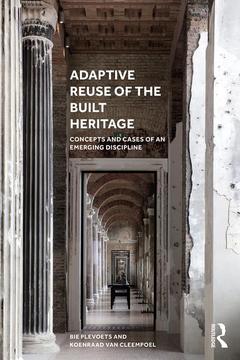Adaptive Reuse of the Built Heritage Concepts and Cases of an Emerging Discipline
Auteurs : Plevoets Bie, Van Cleempoel Koenraad

Adaptive reuse ? the process of repairing and restoring existing buildings for new or continued use ? is becoming an essential part of architectural practice. As mounting demographic, economic, and ecological challenges limit opportunities for new construction, architects increasingly focus on transforming and adapting existing buildings.
This book introduces adaptive reuse as a new discipline. It provides students and professionals with the understanding and the tools they need to develop innovative and creative approaches, helping them to rethink and redesign existing buildings ? a skill which is becoming more and more important. Part I outlines the history of adaptive reuse and explains the concepts and methods that lie behind new design processes and contemporary practice. Part II consists of a wide range of case studies, representing different time periods and strategies for intervention. Iconic adaptive reuse projects such as the Caixa Forum in Madrid and the Rijksmuseum in Amsterdam are discussed alongside less famous and spontaneous transformations such as the Kunsthaus Tacheles in Berlin, in addition to projects from Italy, Spain, Croatia, Belgium, Poland, and the USA.
Featuring over 100 high-quality color illustrations, Adaptive Reuse of the Built Heritage is essential reading for students and professionals in architecture, interior design, heritage conservation, and urban planning.
Introduction. Part 1. 1. Historical Background. 2. Intervention Strategies. 3. Adaptive Reuse for Urban. Regeneration. 4. Genius Loci. 5. Concluding reflections. Part 2. 1. Diocletian Palace, Split (vernacular transformation from the 7th century onwards). 2. Santa Maria degli Angeli e dei Martiri, Rome (Michelangelo, 1553–1556). 3. Castelvecchio Museum, Verona (Scarpa, 1959–1973). 4. SESC Pompeia, Sao Paulo (Lina Bo Bardi, 1977-1986). 5. Attocha Station, Madrid (Moneo, 1984 - 1992). 6. Kunsthaus Tacheles, Berlin (squatter community, 1990–2014). 7. Palais de Tokyo, Paris (Lacaton & Vassal, 2000-2002 and 2012-2014). 8. Library Escuelas Pias San Fernando, Madrid (José Ignacio Linazasoro, 1996-2004). 9. Kolumba Art Museum, Cologne (Zumthor, 2003-2007). 10. Neues Museum, Berlin (David Chipperfield & Julian Harrap, 1997-2009). 11. C-Mine, Genk (51N4E, 2011). 12. Park Spoor Noord, Antwerp (2006-2011). 13. Park Avenue Armory, New York (Herzog & De Meuron, 2006 - ungoing). 14. Sir John Soan Museum, London (Caruso St John, 2009-2012). 15. Former Prison, Hasselt (NoAarchitecten, 2008-2012). 16. OFF Piotrkowka, Lodz (2011-ungoing). 17. Rijksmuseum, Amsterdam (Cruz y Ortiz Arquitectos, 2000-2013). 18. Fondaco Dei Tedeschi, Venice (OMA, 2009-2016). 19. De Flat Kleiburg, Amsterdam (NL Architect & XVW architectuur, 2012-2016). 20. St Joseph church, Ghent (TV TRACE, feasibility study 2017). Index.
Bie Plevoets holds a PhD in architecture and works on theory of adaptive reuse in the research group Trace – Adaptive Reuse and Heritage in the Faculty of Architecture and Arts at Hasselt University, Belgium. She teaches courses on adaptive reuse at BA and MA levels.
Koenraad Van Cleempoel is Professor of Art History in the Faculty of Architecture and Arts at Hasselt University, Belgium, where he is also a member of the research group Trace. He was previously holder of the Pieter Paul Rubens Chair at the University of California, Berkeley, USA.
Date de parution : 05-2019
15.6x23.4 cm
Date de parution : 05-2019
15.6x23.4 cm
Thèmes d’Adaptive Reuse of the Built Heritage :
Mots-clés :
Southeast Bay; built; Foot Paths; design; Specific Building Typologies; interior; Bird’s Eye; sustainability; De Construction; architecture; Nineteenth Century Shopping Arcades; case studies; Historic Urban Landscapes; restore; Bernardo Secchi; repair; Large Families; conservation; Vice Versa; history; David Chipperfield Architects; theory; Street View; regeneration; Adaptive Reuse; intervention; Sir John Soane’s Museum; Palais De Tokyo; Genius Loci; Bauwesen Und Raumordnung; De Flat; Cedric Price’s Fun Palace; Non-buildable Area; Neues Museum; Shaft Towers; Auditoria Building; Diocletian Palace; Hasselt University



